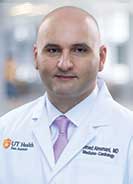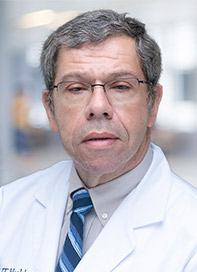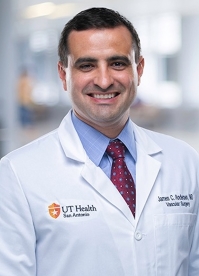Vascular Care that Fits You
At University Health, our vascular surgeons test and diagnose diseases of the vascular system and recommend treatment options tailored to your condition. Our partnership with UT Health San Antonio ensures you have access to the most advanced endovascular techniques and traditional vascular surgery options.
Level I Vascular Emergency Program
Sudden aortic syndromes are life-threatening, and seconds matter when you have a circulatory system condition. Our Level I Vascular Emergency Program has resources and treatment options many outlying or referring hospitals don’t have in-house.
In addition to sudden aortic syndromes, such as thoracic (chest) aortic aneurysms and abdominal aortic aneurysms, we treat a lack of circulation in the arms and legs (acute limb ischemia) and other vascular conditions with a wide range of treatments.
Vascular Treatments
Angioplasty
Dialysis access
Endarterectomy
This is the surgical removal of plaque from a narrowed or blocked artery. A sticky substance called plaque can build up in your artery walls (atherosclerosis) and reduce or cut off oxygen to your organs or muscles. Your vascular surgeon makes an incision in the artery to remove the plaque and restore blood flow.
A carotid endarterectomy may be used to treat your carotid artery disease. During this operation, your surgeon performs the procedure on the arteries on either side of your neck.
Endovascular aortic repair (EVAR)
Endovenous laser therapy (EVLT)
First rib resection
Inferior vena cave (IVC) filter
Phlebectomy
Radiofrequency ablation (RFA)
Sclerotherapy
Stenting
During this procedure, your vascular surgeon inserts a slender, metal-mesh tube, called a stent, into an artery to increase blood flow in areas blocked by plaque. This plaque buildup may result from hyperlipidemia.
Carotid artery stenting (CAS) is a procedure where your vascular surgeon places the stent inside the arteries on either side of your neck.
Surgical aneurysm repair
Your vascular surgeon repairs or removes an aneurysm, an enlarged and weakened section of an artery, through an incision in your skin. An aneurysm is a serious health concern. It can rupture or allow blood clots to form.
Aneurysms can be repaired safely either by open vascular surgery or through an endovascular procedure using a stent graft.
Surgical bypass
During a bypass procedure, your vascular surgeon creates a new pathway for blood flow using a graft. To bypass a blocked leg artery, for instance, a healthy vein from the same leg is used. It may be removed through one long incision or several smaller ones.
In some cases, a synthetic graft is used. Once the graft is ready, your surgeon makes an incision near the damaged artery. The graft is stitched to the artery above and below the blockage. Once blood is flowing through the graft, the incision is closed with sutures or staples.
Thoracic endovascular aortic repair (TEVAR)
Many of our cardiothoracic and vascular surgeons are experienced in TEVAR. We perform this surgery inside your aorta using thin, long tubes called catheters. The catheters are used to guide and deliver a stent-graft through the blood vessels to the aneurysm through small incisions in the groin. The stent graft is then deployed in the diseased segment of the aorta and "relines" the aorta like a sleeve to divert blood flow away from the aneurysm.
We also perform Fenestrated Endovascular Aortic Aneurism Repair (FEVAR) with grafts that are custom designed to fit each patient’s unique aortic anatomy. FEVAR is a minimally invasive surgical alternative to the traditional open aortic aneurysm repair.
Thrombolytic therapy
Venous access
Wound care
We offer wound care for a wide range of vascular conditions. Foot ulcers are among the most common conditions we treat. Ulcers are wounds or open sores that will not heal or keep returning. The three most common types of leg and foot ulcers include:
- Venous stasis ulcers
- Neurotrophic (diabetic)
- Arterial (ischemic ulcers)
Our vascular experts care for each of these conditions in our offices, provide instructions for wound care at home and give recommendations on prevention techniques.



